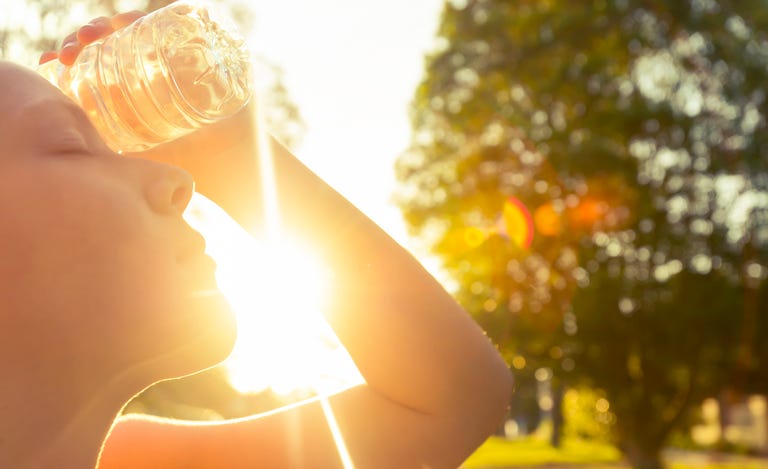How to stay away from heat stroke in summer
(VNF) – This time of year, when many of us are eager to get out and enjoy some summer sun, hot humid weather can put us at risk of heat illness, such as heat stroke.
 |
Illustrative photo (source: Getty)
As the temperature is getting high in the summer, various health problems will arise, for instance, heat exhaustion. It is not serious and usually gets better when you cool down. If it turns into heat stroke it needs to be treated as an emergency.
Summer is short, and many of us want to make the most of it. With some careful planning and a few modifications, you can play it safe and continue to enjoy your favourite activities.
Symptom of heat exhaustion
Usually, a healthy core body temperature is somewhere around 37 C. But if it climbs to 40 C internal organs — including your brain — may become damaged. When core temperature exceeds 40 C and there is any suggestion of neurologic abnormality, such as abnormal behavior or mood, heat stroke must be suspected, says Dr. Mark Leong, Program Director for the Enhanced Skills Program in Sport and Exercise Medicine in the Department of Family and Community Medicine at the University of Toronto, Canada.
According to UK's biggest health website NHS, the signs of heat exhaustion include: headache, dizziness and confusion, loss of appetite and feeling sick, excessive sweating and pale, clammy skin, cramps in the arms, legs and stomach, fast breathing or pulse, temperature of 38C or above, intense thirst.
The symptoms are often the same in adults and children, although children may become floppy and sleepy.
Who are the most susceptible?
“In my work as a sports medicine doctor, I would most commonly see heat illness in endurance sports, like marathons, and intensive outdoor training sessions, like in football. But, you don’t have to be a serious athlete to experience these conditions” said Dr. Leung.
 |
You don’t have to be a serious athlete to experience these conditions. (source: Getty Images)
According to Red Cross Australia, the heat can affect anyone, but some people are more at risk because their body doesn't regulate heat well, including: older people, babies and young children, people with mental-health conditions, people on certain medications, people with chronic conditions (such as breathing or heart problems), people with limited mobility.
Prevention
Prevention is always better than cure. Below are some advices by the Hongkong Occupational Safety and Health Council on helping you avoid heat stroke.
To avoid working in hot environment is certainly the best way to avoid heat stroke, but if not possible, the following measures should be adopted to prevent heat stroke.
First of all, in hot and humid environment, we should take appropriate measures no matter working at indoor or outdoor workplace (e.g., warehouses, docks, construction sites, container yards, kitchens and laundry rooms etc.).
For instance, wearing loose-fitting, lightweight and light-coloured clothing will facilitate perspiration and reduce the body heat.
Taking rest in a cool place at certain time of work is also recommended.
In addition, you are advised to drink sufficient amount of water or other appropriate beverages to replenish fluid and electrolytes lost, avoid beverages that include alcohol, coffee, tea or caffeine to prevent dehydration;
For people who love workout, don’t overdo it. Keep the intensity of your exercise program in line with your general fitness level.
Last but not least, give yourself time to acclimatize. If you’re not used to the heat, allow time for your body to adjust. This is particularly true for people who might be moving to a new climate or travelling.
Cure
In case you see a person suffering from heat stroke, remember, before making an urgent call to medical staff, please practice these following steps:
First, help the person into a shady spot or into an air-conditioned building. Remove excessive clothing. You may consider applying ice packs to the affected person’s groin and armpits, spraying them with a garden hose or ice bath immersion. In short, anything you can do to lower their body temperature quickly can make a difference and may even be life-saving.
A person with heat stroke typically needs hospital monitoring and intervention. The initial goal is to rapidly lower the body temperature and close monitoring for organ damage. A doctor might recommend monitoring for hours to days, with regular temperature checks and investigations to evaluate and respond to signs of organ damage, such as to the kidney, liver, heart, and brain. Sometimes imaging, intravenous fluid resuscitation and medication are required. Return to exercise after exertional heat stroke should be guided by a medical doctor./.
( VNF )
Recommended
 Handbook
Handbook
Vietnam Moves Up 8 Places In World Happiness Index
 Handbook
Handbook
Travelling Vietnam Through French Artist's Children Book
 Multimedia
Multimedia
Vietnamese Turmeric Fish among Best Asian Dishes: TasteAtlas
 Handbook
Handbook
From Lost to Found: German Tourist Thanks Vietnamese Police for Returning His Bag
Popular article
 Handbook
Handbook
Prediction and Resolution for the Disasters of Humanity
 Handbook
Handbook
16 French Films To Be Shown For Free During Tet Holiday In Vietnam
 Handbook
Handbook
Unique Cultural and Religious Activities to Welcome Year of the Snake
 Handbook
Handbook



